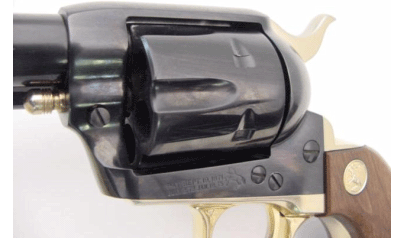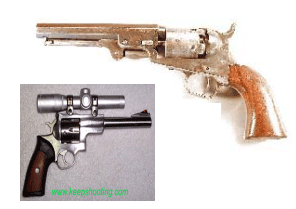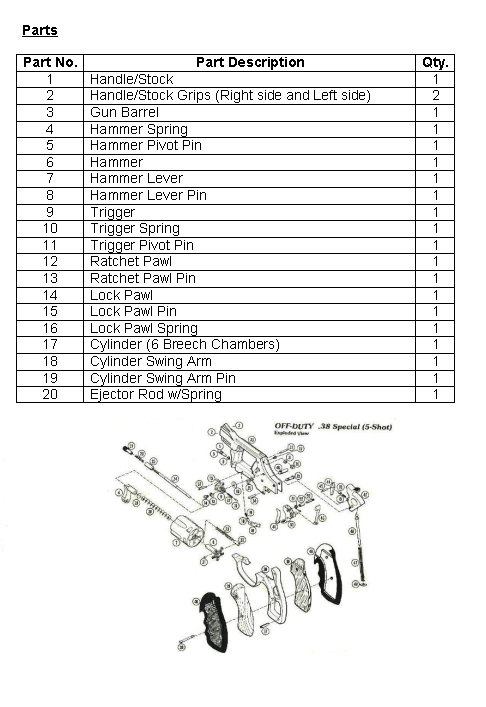
 The
first patented revolver ever was created by a man by the name of Sam Colt.
When Sam was young, he was fascinated with guns and often took his dad's
apart and re-assembled them. When Sam was older, he had an idea for a
revolving gun that would be easier to load and fire. He carved out a wooden
model and had the mechanics patented in February of 1836. The revolver
was beloved by the Rangers in Texas due to its accuracy, and the fact
that 5-6 shots could be fired consecutively without reloading.
The
first patented revolver ever was created by a man by the name of Sam Colt.
When Sam was young, he was fascinated with guns and often took his dad's
apart and re-assembled them. When Sam was older, he had an idea for a
revolving gun that would be easier to load and fire. He carved out a wooden
model and had the mechanics patented in February of 1836. The revolver
was beloved by the Rangers in Texas due to its accuracy, and the fact
that 5-6 shots could be fired consecutively without reloading.
In present times, the handgun, although much more advanced, still relies
on many principals of the original Colt Revolver. Most modern day handguns
use the same principal of having a hammer strike the back or firing cap
of a projectile, then having the chamber reloaded with another projectile.
This allows for a faster rate of fire and decreases down time between
loadings.
Handguns have been used for many things from the time they were invented
up until present day. All military, defence and law enforcement officers
use guns to protect the citizens of their cities and countries as well
as to protect allied countries. Guns are used in accuracy competition,
weither it be through small organizations or even up to the Olympic level.
On the dark side, handguns have and are still being used to harm people
to gain power, money or just personal satisfaction. Thankfully, much is
being done to prevent the use of guns in a negative way through registry
or imprisonment.
The revolver handgun has a series of breech chambers aligned in a circular pattern. This chamber grouping is called the cylinder. Each of these breech chambers holds the projectile that is to be fired. When the trigger is pulled, the hammer is pushed backwards. At the same time, there is an object called a pawl that contacts the ratchet of the cylinder and rotates it so that the next breech chamber is aligned with the gun barrel. When the chamber is perfectly aligned, another pawl locks onto the cylinder and holds it in place while the first pawl returns to its previous position. Once the trigger has been pulled back to its firing position, the hammer springs back to its original position allowing its firing pin to extend into the breech chamber and strike the projectile's primer. This propels the projectile through the gun barrel and towards its target.
 All
parts are linked through pins, compressed springs and. The hammer is hard-pressed
back towards its original location via a spring that is loaded in the
gun stock or handle. The hammer is pushed back, when the trigger is pulled,
by a lever system that is attached to the hammer. When the trigger is
pulled, part of it rotates the lever attached to the hammer and the hammer
is pushed back, compressing the spring in the gun stock. This lever system
is the most crucial part of the revolver because it must be designed so
that the hammer will not release until the breech chamber is aligned with
the barrel. If the timing is too early, the hammer will not contact the
primer and will misfire or even fire inside the gun severely injure the
user. If the timing is too late, the hammer will not be released at all
or might be released too late causing the same errors as if it were too
early.
All
parts are linked through pins, compressed springs and. The hammer is hard-pressed
back towards its original location via a spring that is loaded in the
gun stock or handle. The hammer is pushed back, when the trigger is pulled,
by a lever system that is attached to the hammer. When the trigger is
pulled, part of it rotates the lever attached to the hammer and the hammer
is pushed back, compressing the spring in the gun stock. This lever system
is the most crucial part of the revolver because it must be designed so
that the hammer will not release until the breech chamber is aligned with
the barrel. If the timing is too early, the hammer will not contact the
primer and will misfire or even fire inside the gun severely injure the
user. If the timing is too late, the hammer will not be released at all
or might be released too late causing the same errors as if it were too
early.
When all of the projectiles have been fired, the cylinder is removed from the body of the handgun by a swing are that is inserted into it. This cylinder/swing arm combination is kept inline in the revolver by an ejector rod that the cylinder rotates around. When the ejector rod is pulled outward towards the barrel of the revolver, the cylinder and swing arm can be released from the gun.

The modern day revolvers that are being created can have up to 50 components that all aid in the accuracy, ease of use, quality, and visual appeal of the gun. Much time and money have been given in the research of handguns weither it is a revolver or a semi-automatic handgun.